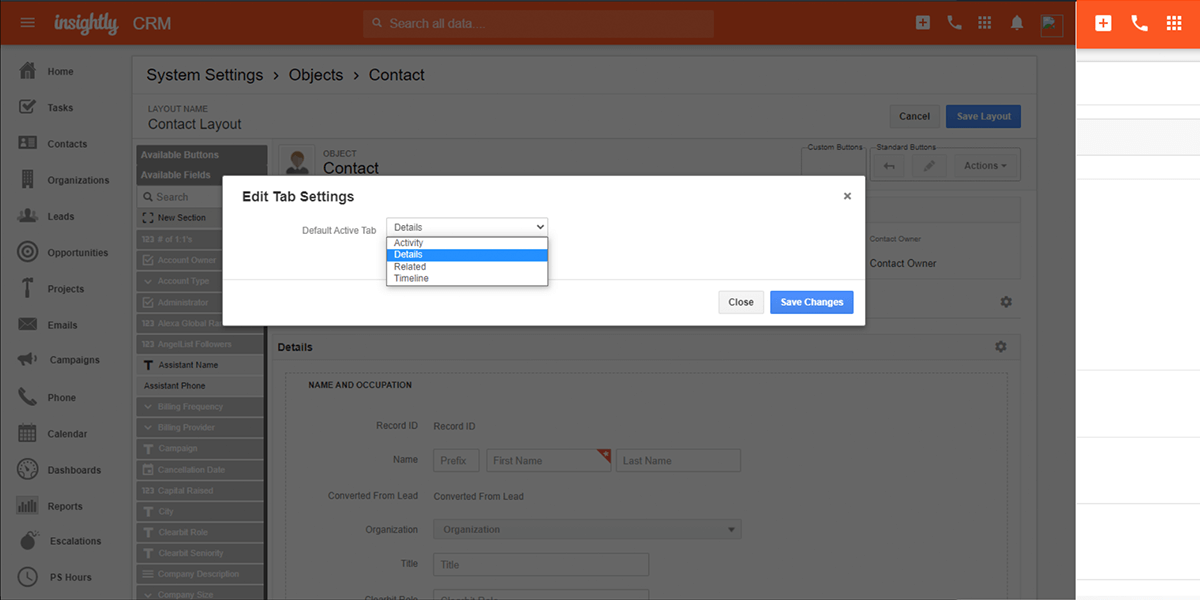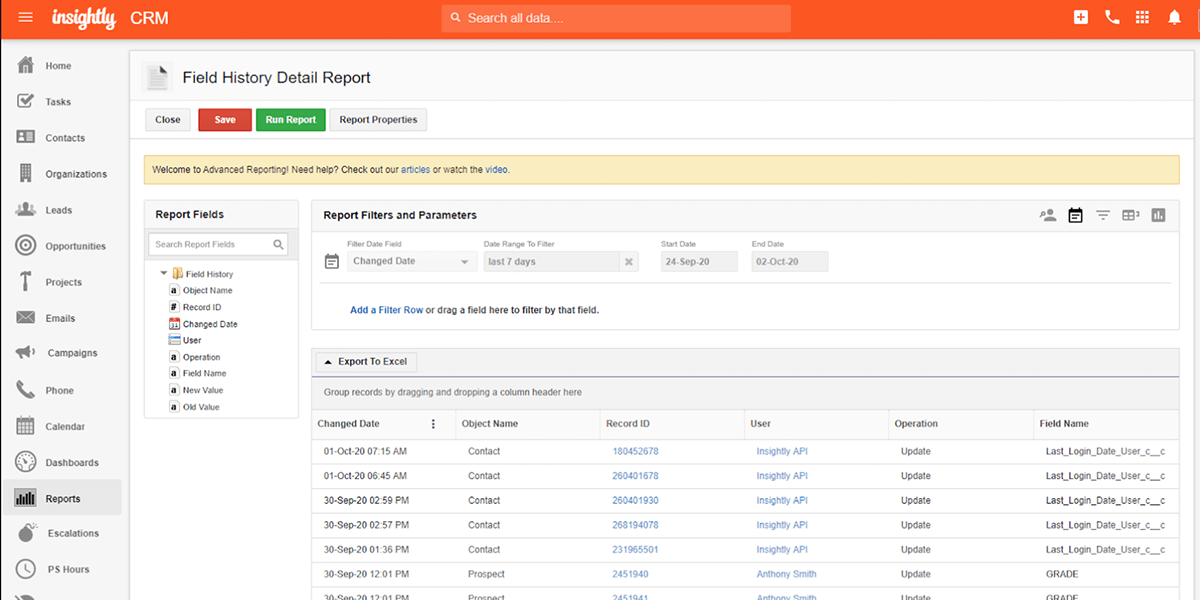The post 9 steps to choose the best CRM appeared first on Insightly.
]]>A CRM solution is an essential part of your company’s digital transformation. You can eliminate redundant interactions, departmental silos, and customer frustrations. You can maintain all your customer data on one central platform. And you can create new assets like dashboards, visualizations, and apps with incredible speed.
For example, your sales team leads can view individual interaction maps and know exactly where prospects are in your funnel. You can track each prospect’s unique paths through your marketing and sales pipeline.
Most importantly, you can use a CRM to develop and maintain long-lasting customer relationships.
Define your CRM needs
Before committing to a CRM solution, identify the business needs it should address. Determine the aspects of your current sales and marketing system you want to maintain. Next, ask yourself which goals you’d like to accomplish. And finally, answer these critical questions:
- How do you currently track marketing prospects and sales leads?
- How do you manage ongoing customer/client relationships?
- Do you use the same CRM software for all front-end operations?
- What redundancies exist between your current systems?
- What will it take to switch CRM platforms?
- Which new technologies do you want to leverage? Consider customized dashboards and visualizations, app development and deployment, and AI data analysis, forecasting, and machine learning.
Once you’ve answered these questions, here’s what you need to do next to get started.
1. Assemble a cross-functional team
Because your CRM software will affect a wide array of stakeholders, you need a cross-functional needs assessment team. This group should represent senior leadership, middle managers, and the front-end staff who will use your new CRM every day. Invite specialists like IT people and CRM admins – as well as generalists and creative thinkers.
Choose a leader for this group who has an excellent understanding of all your customer-facing operations. This person will take responsibility for the project, ensure team member accountability, and deliver a data-backed decision. Consider operations or data managers, sales leaders, or IT leads for this position. Most of all, this person should balance details with general perspectives and have excellent communication skills.

2. Collect feedback from future users
Your new CRM software will integrate all your front-facing operations into one system, so touch base with everyone who will use it. Have leaders ask their teams what functionalities they value in your current system, what customer experiences they wish you could offer, and what workflows and interactions they wish you could track?
Create a comprehensive needs list like this:
- Secure customer data management
- Lead management
- Project management
- Workflow automations, integrations, and customizations
- Sales automations like product and price catalogs, quote books, territory management, etc.
- Marketing automations like campaign management, email marketing, lead scoring, etc.
- Data analytics and reporting
- Mobile CRM access
- Data management during the transition to this new CRM
- User training and ongoing support
- Implementation requirements and total cost of ownership
3. Analyze and synthesize feedback
Meet with a small group of stakeholders and parse your feedback data. Look for similarities between ideas, issues, and feature requests that may signal important trends. Group these into categories such as important features, cost and licensing, scalability, integrations, and support.
4. Prioritize your CRM needs and wants
Choose a CRM solution that meets the needs of your customer-facing teams. As you review your analysis, differentiate between each department’s “must-haves” and “wants.” Look beyond the needs of any single group to be sure your new CRM is easy to scale up as your business requirements grow and change.
Assess CRM vendors
To properly assess all the CRM solution vendors available, consider some key questions, including:
- Which one offers the right mix of features for your organization of all the CRM companies out there?
- Which CRM tool allows access to real-time customer relationship data?
- Which contact management suite tears down the invisible barriers between your marketing, sales, and support teams?
- Does your CRM software map interactions in real-time so your team members can speak with confidence and relevance? For instance, your sales manager may want to follow up with current customers to track relationships.
- And most importantly, how will your new system protect your customer’s personal information?
5. Identify solutions that fit your needs
Every department will need different features from your CRM. For example, your:
- Marketing teams may want CRM features like custom dashboards and detailed lead management visualizations.
- Sales managers may want to know how far prospects have progressed through your sales pipeline.
- Content creators may require clearer perspectives on the email and workflow builder, and its content creation interface.
By determining all the features your company needs, you can compare CRMs and make the best decision for your company.
6. Keep an eye out for CRM costs
Big names don’t mean big savings and every feature you require. Some legacy CRMs may include features that don’t meet your business needs. Alternatively, these older CRM solutions may not have the new technologies necessary to increase your market share.
CRM providers typically offer tiered pricing per user that facilitates scaling. However, look out for hidden fees and ensure the features you want are in the tier you choose.
7. Hop on trials and demos
After comparing the benefits of the CRMs on your list, pick two or three to examine in depth. The most efficient way is to schedule live demos and sign up for free trials.
Have your tech team test out integrations, customizations, and add-ons. Ask your marketing team which CRMs provide the conversion statistics they need to get the most from your ad budget. Have sales teams test out custom ticket automations and role-based permissions.

8. Remember these essential CRM characteristics
As you’re testing potential CRM solutions, consider the following essential factors that may matter most for everyday use:
- Implementation—Choose someone who understands team workflows and tech logistics to create a new CRM implementation plan. Although you probably want a CRM software suite with comprehensive functionality across many departments, you also need a CRM system that integrates with your existing software and data.
- Adoption rate—While a CRM software suite with comprehensive functionality across many departments is a wise choice, you also need a CRM system people will actually use. According to this 2019 report, experts differ on the causes of low adoption rates, such as bad experiences, poor onboarding, and negative preconceptions. However, the data shows that users engage more with systems that are easy to use, and include mobile apps.
- Customization and workflows—Even though a particular CRM software package may look like the right one on the surface, be sure to dig deeper, so have your teams test the limits of dashboard customizations, email design tools, and analytics.Make sure your new CRM can handle everything your teams throw at it during their daily workflows. Do a few test runs with salespeople playing the part of customers. That way, you’ll know you’re making the right choice.
- Support—A CRM system is only useful to your organization if users can quickly and easily get the help they need. From salespeople to tech people, everyone eventually needs help. Be sure the CRM you choose provides comprehensive customer service and support.
- Integration: A unified platform—You can save big bucks with a single, unified CRM solution that eliminates redundancies and helps you create efficiencies. However, integrating all your client-facing operations into one system can be difficult. So have your tech teams work closely with team leads to ensure your CRM can deliver on its all-in-one promises long before deployment day.
- Scaling and growth—Your CRM is the central hub of your customer-facing operations. Adopting new CRM software can put a massive strain on your teams. Be sure the platform you choose will easily scale to your growth. That way, you’ll avoid massive headaches by not having to change CRMs every time you expand.
- Smooth transitioning—Your new CRM software should seamlessly integrate with a wide array of third-party applications. Make sure your CRM works well with the tools you use now and the tools you’ll rely on as you scale up.Of course, your CRM will also need to integrate with your existing system. It’s crucial to preserve your current customer relationship data as you transition to a single, unified CRM.
- Compliance—Your organization needs to show it meets all current digital privacy requirements for the countries in which you’ll be operating. Be sure the CRM software you choose has powerful and up-to-date customer information protections. Nothing matters more than building and maintaining customer trust, so your CRM should be able to support those goals.
- Ease of use —Although your team needs to feel comfortable using your new CRM platform, consider how it looks to your customers. Find out if their experience is pleasant? Does your CRM software feel intuitive? Have team members play the role of the customer. They’ll learn a lot about each CRM’s UX by opening emails, clicking through funnels, and filling out forms.

9. Choose the best CRM system
Ultimately, you need to discover what feels right for your workflow and your teams. Take your time, test potential new CRMs, and check in with your colleagues. Together, you’ll find a set of tools that supports all your organization’s front-facing teams.
Marketing, sales, and support teams love a unified CRM
Insightly provides the versatility you need to quickly and easily scale your operations.
With Insightly, integration and dashboard customization are a snap. Our users appreciate our massive suite of relevant and powerful tools. Insightly’s adoption rates are incredibly fast because people enjoy using our tools.
Rely on Insightly for everything from broad-scope analytics to single-customer views. Our CRM software gives you unparalleled perspectives on your most precious asset: customer relationships.
Make us the nerve center of your entire customer service infrastructure. Click here for a free trial of Insightly.
The post 9 steps to choose the best CRM appeared first on Insightly.
]]>The post The CRM process is flawed. Here is why. appeared first on Insightly.
]]>A unified CRM is what’s required to thrive in a competitive landscape. The tools and data integration that it provides enable all of the company’s teams to seamlessly achieve synergy. They enable you to gain more insights and deliver a better experience.
Let’s dive deeper into the ways Insightly’s unified CRM software can have a transformative impact on your business.

What is the CRM process?
The CRM process can be best described as a business strategy that enables companies to better identify and interact with current and potential customers.
The idea here is to improve personalization for every customer interaction for enhanced customer experience and loyalty through data analysis and segmentation tools.
The same approach is also leveraged for prospects to convert them into paying customers. The five core steps of the CRM process signify a collaborative effort between the key departments in a company.

The 5 steps of the CRM cycle
1. Increase brand awareness
Typically the marketing team’s domain, the first step in the customer relationship management process involves introducing prospects to the business. It requires in-depth research on the audience’s demographics and interests.
Audience personas are created based on this market research to launch marketing campaigns that will theoretically have a greater chance of resonating with the audience.
2. Acquire more leads
The lead acquisition step is generally handled by the sales or marketing teams, or in some companies, both. This is essentially an effort to get prospects to engage with the business.
For example, the marketing team might offer downloadable content as a lead magnet to website visitors if they provide an email address. The sales team could then pull that data from the CRM to proactively target prospects to convert them into customers.
3. Convert leads into paying customers
Reps nurture leads to get them to convert to paying customers in this part of the sales process. They usually rely on lead-scoring data in the CRM to identify prospects that may have the highest probability of a sale and follow-up diligently with the lead.
Converting prospects into new customers is more of an art than a science. Sales reps must be skilled at building trust to inspire confidence in the leads to convert them into paying customers.
4. Retain customers with customer support and customer success
The job doesn’t end when the lead converts into a customer. Providing them with exceptional customer service is key to ensuring that they remain loyal customers.
The most widely used metric in customer service is CSAT or customer satisfaction. This data is used to track trends and identify and fix any issues impacting customer service.
5. Extract more value per customer with upsells/cross-sells
Upselling and cross-selling are great opportunities to proactively meet the needs of your customers by utilizing the data in the CRM. Companies should be mindful of the fact that customers’ needs may change over time.
This can be achieved by leveraging purchase data to provide personalized recommendations on the products and services that would provide further benefit to the customers.

Why the CRM process is flawed
Not all companies are created equal. The customer journey will always be different for every company. What works for one may not necessarily work for the other. This crucial fact tends to be overlooked by the CRM process.
What ends up happening is that the data gets compartmentalized in different tools. It turns into a mess as data discrepancies inevitably occur when all teams are not entering data into the same system.
This causes friction between various teams, including sales and marketing, since they effectively work in silos with complex ad hoc data sync processes.
Employees thus end up not trusting the data as it doesn’t provide them with a holistic view to make empowered decisions. They come to question the integrity of the data because it doesn’t appear to be cohesive and comprehensive.
They also find it difficult to achieve synergy with colleagues on other teams. Alignment across teams is crucial to close more customers and to improve retention.
A real-life CRM process example
A legacy CRM is effectively used as a suite of apps by a company. All of the sales, marketing, and service data is collected and managed in separate silos.
Thus, in reality, these so-called “integrated” CRMs are actually “assembled” CRM software where features and functionality were added over time in response to customers’ needs.
These solutions don’t fit the customer journey, particularly for companies that offer multiple products and services. The many teams that work on them use different tools that all do the same thing but don’t allow for seamless data integration. It’s impossible to have confidence in the data when it’s scattered everywhere.
There’s no continuity between the various tools in the CRM system, which prevents them from having an up-to-date and comprehensive view of the customer journey.
This will prevent, for example, the hardware and software sales teams in a company from leveraging the upsell/cross-sell opportunities that may exist with their customers simply because their data is all over the place.
Trying to fully integrate the scattered data is an expensive and time-consuming proposition, often making efforts to achieve that futile.

A better, adaptive approach to the CRM process
1. Start with the customer journey
The customer journey is a vital part of any CRM integration. Most solutions go about it the wrong way by forcing the customer journey to adapt to the CRM process.
Think about it, what works for a customer who wants to buy hardware might not work for someone who’s buying software. The same CRM strategy can’t be used for both.
It should be the other way around. The CRM process needs to be flexible enough to adapt to the customer journey. This increases the potential of converting leads and enhancing retention regardless of what stage of the sales pipeline they’re in.
2. Integrate with your existing tools
A single customer view that centralizes all customer data is a powerful tool to achieve synergy. Its integration with all of the existing tools that a business uses is also of vital importance.
Insightly AppConnect is a tool that allows for integration automation. Companies can use it to link and integrate Insightly’s unified CRM system with the other apps they use in their organization.
This allows for powerful new workflow automation between applications. AppConnect also features over 500 pre-built connections to popular business apps.
Even non-technical users can build seamless integrations by using its simple drag and drop interface without writing a single line of code.
3. Take a unified approach
Companies can both extract the most from their CRM implementation and improve customer service by adopting a unified approach that no longer relies on redundant tools and the compartmentalization of data in silos.
They can achieve synergy and data integration by unifying the marketing, sales, support, and project management on a single platform. All of the teams work together with a holistic view of the customers’ needs and expectations.
One of the biggest benefits of a unified solution for teams is that they can complete many tasks in one single system. They no longer have to switch between multiple applications to use various tools just to access data, a task that unnecessarily slows them down.
Insightly puts this unified approach at the heart of its CRM solution. Teams’ productivity increases through automation. With business intelligence built in, Insightly can also be used to create data visualizations and real-time data dashboards for unmatched visibility.
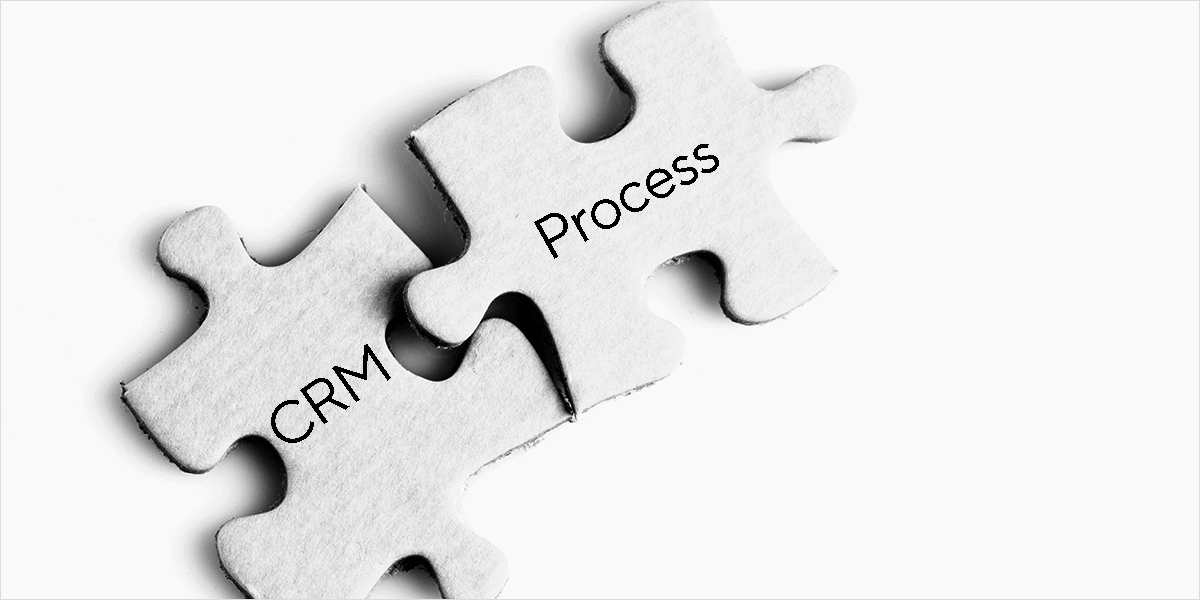
Insightly unifies your CRM process
Insightly empowers organizations and even small businesses to align sales, marketing, and support teams so that they have complete visibility over customer relationships. They can use that insight and knowledge to improve customer service.
Automatic lead routing ensures that leads are routed to the right person in real-time. With workflow automation, companies can create complex, multi-step business processes to better serve their customers. It can even execute custom business logic to sync with external systems from the likes of SAP and Oracle.
AppConnect ensures that the ecosystem of tools that a company uses every day isn’t disrupted; rather it’s integrated seamlessly with the CRM. AppConnect comes with more than 500 pre-built connections to the most popular business software apps. This makes establishing seamless integrations between the CRM and apps very straightforward.
Interested in learning more about how a real single customer view can enable you to improve customer retention and to better connect with them? Try Insightly for free to feel the unified CRM difference for yourself.
The post The CRM process is flawed. Here is why. appeared first on Insightly.
]]>The post 5 key CRM integrations in 2021 appeared first on Insightly.
]]>But how can your company be strategic when data are created and stored in so many different locations and formats? Email inboxes, social media sites, document repositories, and other third-party software tools are just a few of the places where your data live.
Integrating your CRM is certainly an option, but where should you start? Is integration worth the effort?
In this post we’ll explore CRM integrations and discuss five important integrations to consider in 2021.
Why use CRM integrations?
Before we dive into specific integrations to consider in 2021, let us first examine why CRM integrations are necessary. After all, you’ve already made a considerable investment in your CRM. Shouldn’t it do everything you need without relying on other systems?
Not exactly. Here’s why.
Even the best CRM can’t do everything
Last time I checked, no CRM will run a profit and loss report or statement of cash flow. Nor should it. And, although CRM technology continues to advance and encompass more aspects of daily life for businesses, the reality is that CRMs are not built to support every process and workflow. System consolidation can be wise, but total elimination of non-CRM technology is simply infeasible (at least in 2020). Therefore, integrating mission-critical apps to your CRM makes good sense.

Some tools become more useful when enriched by data stored in your CRM
You’ve put great effort into making your CRM the central source of truth for your organization. Maximize the usefulness of that data by making it accessible in other mission-critical apps, such as email inboxes and team collaboration platforms.
Not every team member requires direct access to your CRM
Sales, marketing, and project teams tend to be the heaviest users of CRM technology. That being said, there are many other teams who do not (or should not) require access to your CRM. Does your freelance graphic designer really need a CRM license? Perhaps not. On the other hand, she does interact with customer-related projects. What’s the right answer? Integrating her workspace to your CRM could be the perfect solution.

Managing relationships is messier than ever
No matter how much thought you put into engineering the perfect customer journey, some relationships do not fit into a nice and tidy box. Creating additional web-to-lead forms and autoresponder emails will never stop some customers from circumventing your ideal workflow. In today’s digital world, customers have more ways to engage your company than ever before.
Building integrations to third-party platforms (in particular to social media and email) makes your company better prepared to handle these situations, avoid data loss, and elevate customer relationships.
Integrate these five things in 2020
So, what should be on your integration to-do list in 2020? Here are the five system integrations that will deliver the most value to your organization.

1. Inbox
Stop and think. How much time do you spend in your inbox on a typical day? Now, multiply that across your entire staff. If you’re like many companies, email is still your most frequently used tool. Email offers a convenient platform for outreach and engagement, but it’s not ideal for organizing relationship data.
A better approach integrates your CRM and email, allowing users to quickly access and edit relationship data without leaving their inboxes.
Tip for Insightly users: Insightly Sidebar for Gmail makes it easy to view and add contacts without leaving your inbox. You can also save email messages into Insightly with a click of a button. The Insightly Sidebar for Outlook is also available for customers who use Outlook.

2. Financial data
Cash flow is the lifeblood of any business. When customers fail to pay their invoices on time, your company suffers. Unfortunately, for many organizations, customer relationship management and billing fall into two separate departments that rarely speak to each other.
Integrating proposal, invoice, and payment data into your CRM creates transparency for front-line staff who are most likely to engage with customers, thereby reducing past-due situations and increasing cash flow.
Tip for Insightly users: Insightly integration for QuickBooks Online pulls in invoice and payment data into a dedicated tab on the customer’s record in Insightly.
3. Documents and files
Your CRM is an excellent place to collect customer contact information, notes, memos, and small chunks of relationship data. However, some data sources are best retained in their original format (i.e. complex pricing spreadsheets, photos from trade shows, and product spec sheets).
Attaching downloaded copies of files to CRM records is one option, but a better solution integrates your CRM to a cloud document management system. Linking to live versions of an online document maximizes collaboration and minimizes the possibility of confusion caused by revisioning.
Tip for Insightly users: Insightly offers a number of document integrations, including Dropbox, Box, Google Drive, OneDrive, Evernote, and others.

4. Team chatter
With the advent of remote work and collaboration apps, such as Slack, team members spend more time “chatting” than ever before. This online chatter represents real business value, but value is decreased when data remains isolated from your primary source of truth. In a similar way, online conversations become much less meaningful when collaborators do not have direct access to CRM data. Manually logging into a separate system to search for records is not always feasible, especially in today’s fast-paced business environment.
Ideally, your team collaboration system should have a direct line into your CRM, thereby enabling data-driven conversations and avoiding the creation of new data silos.
Tip for Insightly users: Insightly for Slack allows users to quickly search for, find, and add notes to Insightly records without ever leaving Slack.
5. Everything else
Your CRM vendor cannot integrate to all of your mission-critical apps. That’s why integration platforms are so useful. For example Insightly AppConnect is a no-code integration tool that connects Insightly CRM with hundreds of applications you use across your entire organization. Learn more here.

Move faster with CRM integrations
In summary, connecting your CRM to mission-critical applications will help your company build a more data-centric culture that elevates efficiency, reduces data confusion, and, ultimately, helps your teams move faster.
Check out Insightly AppConnect to browse the complete list of integrations. Not a customer? Request a free product demo and CRM needs assessment with an Insightly rep.
Last updated in July 2021
The post 5 key CRM integrations in 2021 appeared first on Insightly.
]]>The post 3 ways to use CRM data in building customer journeys appeared first on Insightly.
]]>Unfortunately, in today’s omnichannel business landscape, creating one map that represents the entire customer journey can seem daunting—if not impossible. After all, some customers are very candid about their motivations and desired outcomes, while others are less willing to open up. Some customers prefer to interact through face-to-face conversations, while others rely on non-verbal forms of communication, such as email, social media, or text message.
With so many personas, goals, motivations, and communication styles to consider, how can you ever develop a single document that represents the customer journey? One way to do it is to start small and develop your customer journey map over time.
Here are three mapping exercises to help you use CRM data in developing different types of customer journeys for your business.
1. Define your ICPs & personas
Customer journey mapping is a waste of time until you have developed a very specific understanding of your ideal customer. Start by clearly defining your ideal customer profiles (ICPs) and personas before spending any time on journey mapping. If you do not have an ICP or personas, consider the following questions:
- If you could only sell to one industry, what would it be?
- Within that industry, what is your primary niche?
- Within your ideal industry and niche, what are the firmographic characteristics of your ideal customer ? (i.e., revenue size, line of business, number of employees, etc.)
- Of the companies that you’ve served in the past, which were less than ideal? Why?
- Who are the types of people (job titles, responsibilities) that your company interacts with?
- Which job titles tend to make decisions about your products or services?
- Which gatekeepers and other stakeholders are involved in the buying process?
- Who will be the actual users or consumers of what you provide?
There’s a lot to think about when developing your ICPs and personas. You may not have all of the answers, and that’s normal. Use your CRM data and build reports that help you answer the tough questions. Your sales team is also a reliable source of first-hand knowledge to help you check your assumptions. Collect all of the feedback and begin simplifying it for the next step.
Example: A manufacturing business that makes and sells assembly line equipment could theoretically have numerous ICPs and personas. However, for customer mapping purposes, it may be beneficial to focus on one industry at a time—especially if buying patterns and customer service requirements vary significantly by industry. Instead of trying to force all industries into a single map, the manufacturing company would be better served to develop one map for automotive, one for healthcare, and so on. The first step would be to itemize each industry’s ICP and persona(s) as follows:

2. Analyze CRM data for closed-won deals within each ICP
Once you’ve defined your primary ICP(s), it’s time to use data from your CRM to identify trends that are common to each journey. Drill down using tags or custom fields and quickly identify won deals that fall within your target ICP. Be sure to set a date range that provides enough meaningful data.
Do you notice any similarities? Things to look for may include:
- Similar interactions in the journey from awareness to close
- Content that was frequently downloaded or viewed on your website
- Marketing emails that helped move deals forward
- Lead sources that were responsible for a sizable percentage of closed deals
- Typical customer buying processes and the personas who were involved
- Objections that were noted during the sales cycle
- Average amount of time that was required to close each deal
- Post-close and implementation details
Note: Looking at closed-lost deals can also be instructive, but you may not need to do it if you have enough closed-won data.
Use actual deal data to build a more complete view of the customer profile. Going back to our previous manufacturing example, the company’s automotive ICP may look something like this:

3. Start building your customer journey map
Having enriched your ICPs and personas with reliable data from your CRM, you’re now ready to begin constructing a basic customer journey map. What’s the best format for your business? There’s no one-size-fits-all template that works for every industry and use case, so here are a few tips for designing a simple, yet effective customer journey map:
Grid layout
Most customer journey maps are built using a graph-based design and have horizontal and vertical axes. Above the grid, it’s important to have your ICP and persona clearly defined. If you’ve developed fictitious personas with names and photos, this might be a great place to use them. Remember, each map should be specific to one persona / ICP combination. If you have several customer journeys to map, start with the most important persona. If certain maps are very similar, you can always combine them or eliminate some later.
Horizontal axis
The horizontal axis of your graph will most likely align with specific stages that customers go through from pre-awareness to satisfied customer. Using your internal sales pipeline terminology could work, although it is better to describe the stages from the perspective of your customer. So, instead of “initial discussions,” you might use the phrase “research vendors.”
Vertical axis
Some customer journey maps try to squeeze as many criteria into the vertical axis as possible. This can lead to an overwhelming experience that defeats the original purpose of mapping. Decide on three to four important criteria as a starting point for your y-axis. Customer actions, customer feelings and thoughts, and common objections are good examples. You can always add more later.
Example customer journey map
Based on our previous example, here’s what a simple customer journey map might look like. You could build this in a document or spreadsheet and hand it off to a designer to pretty up later. The main goal is to get your basic facts on paper as quickly as possible:
Persona: VP Process Engineering – Plastics (Automotive ICP)
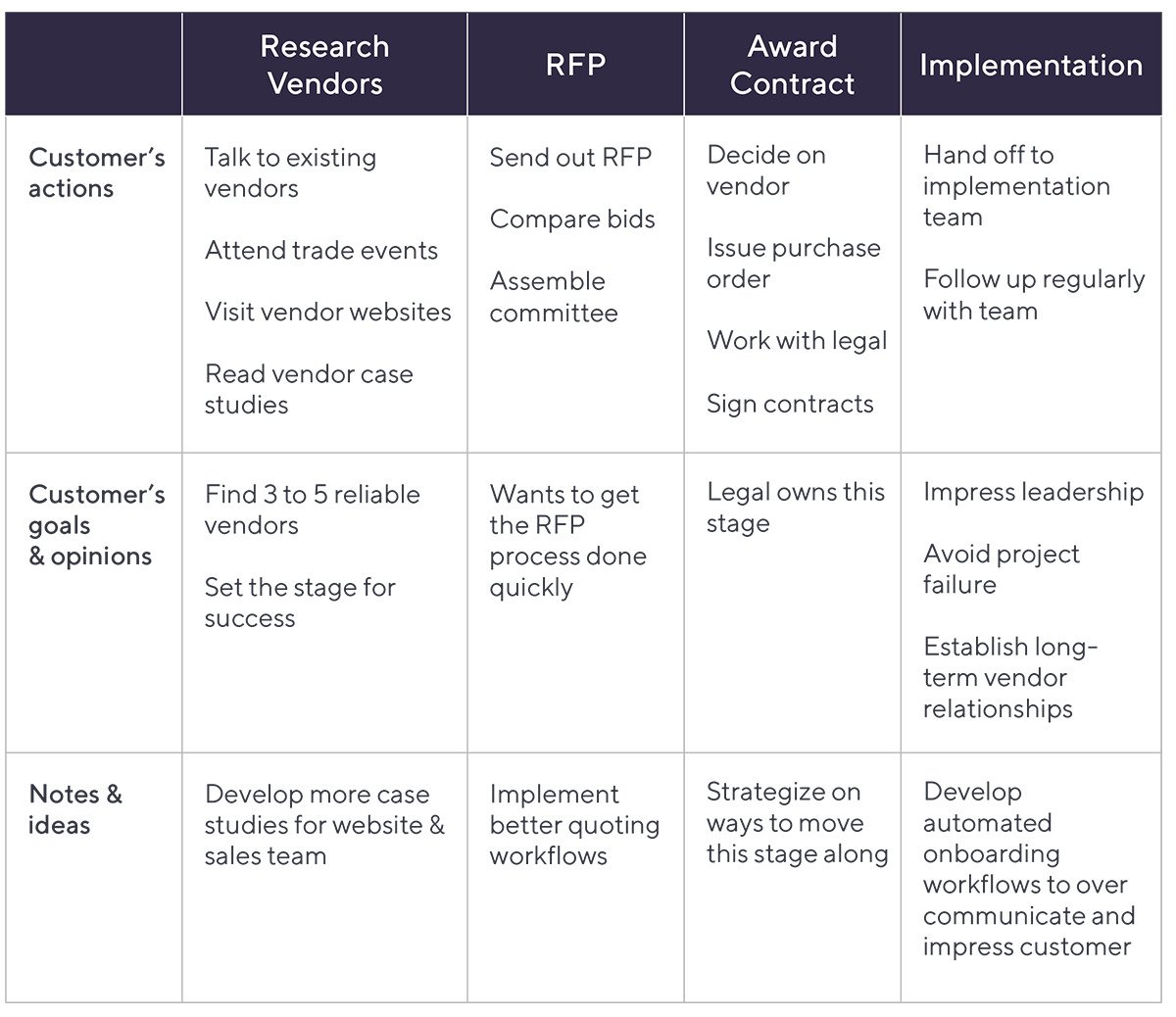
Notice that the map’s last row provides space to collect notes and ideas for streamlining each stage of the customer journey. In this example, developing “automated onboarding workflows” is listed as one opportunity to help the customer achieve his or her goal during implementation. Using a tool like Insightly Marketing can be an intuitive and effective way to automate various aspects of the customer journey—from initial awareness to repeat buyer.
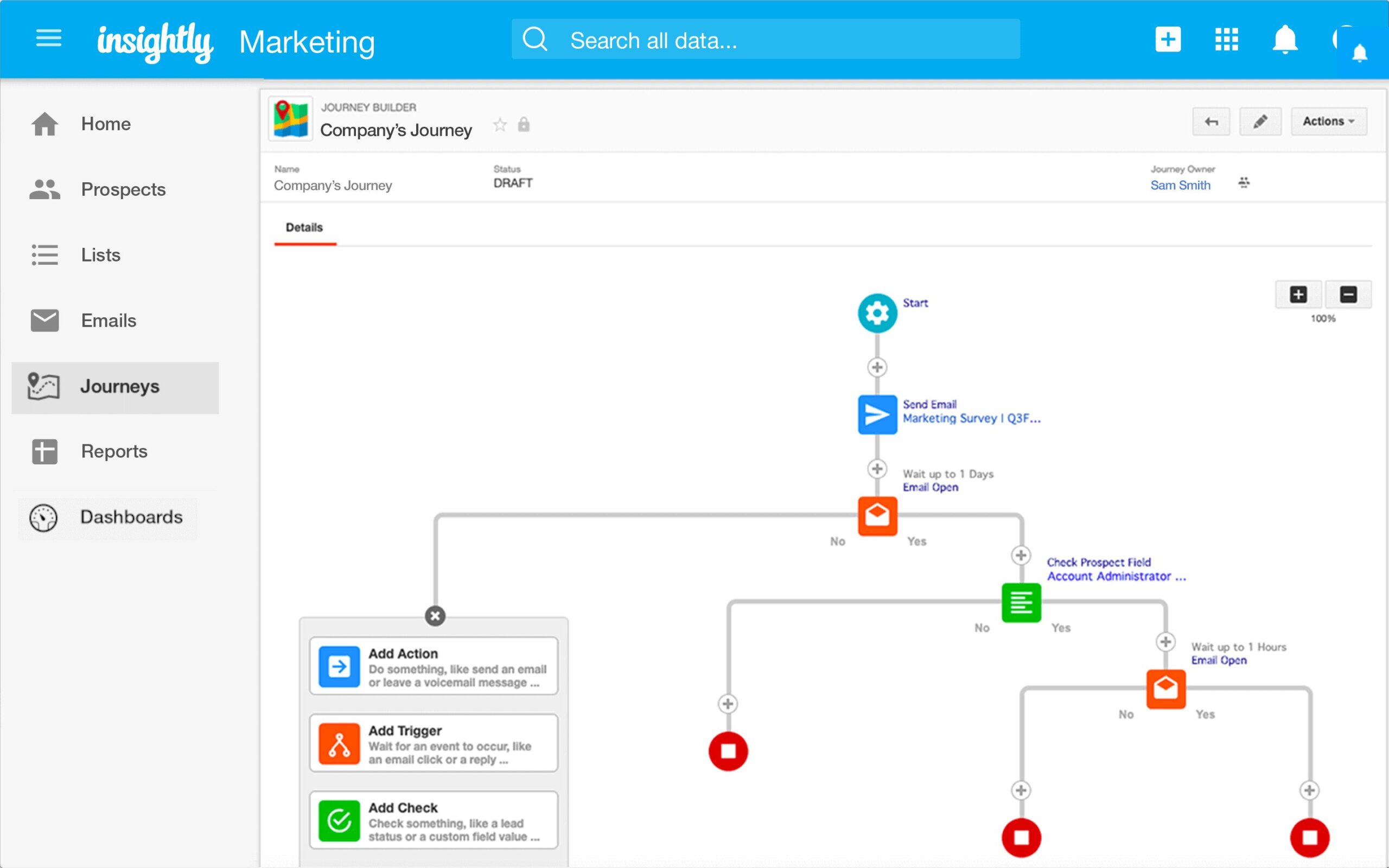
Build better customer journeys
As the business world evolves at an even faster pace, smart companies are realizing the importance of building accurate and actionable customer journey maps.
Not sure how to get started? Keep it simple. Rely on data that already exists in your CRM. Focus on business impact rather than worrying about design effects. And, once you’ve built your customer journey map, use it!
To learn more about Insightly Marketing and CRM platform, request a demo.
The post 3 ways to use CRM data in building customer journeys appeared first on Insightly.
]]>The post Balancing CRM best practices with the need for customizations appeared first on Insightly.
]]>As a business leader, you see both sides of the issue. You want data integrity, but you also want to empower users with the right mix of tools and information. What’s the best approach?
Here are four steps for striking a balance.

1. Develop a cross-functional CRM team
Some organizations wrongly assume that their CRM should be entirely owned and managed by sales (with occasional assistance from IT). Revenue-generating teams may be some of the heaviest users of CRM technology; but, they’re not the only stakeholders. A properly implemented CRM should serve as the source of truth for your customer data, which includes everything from basic contact information to web interactions and attitudinal insights. Storing all of your customer data in your CRM forms a solid foundation for understanding the customer journey—which benefits everyone, not just sales.
Data-driven customer journeys don’t just magically appear in your CRM. Rather, they require a company-wide commitment to efficient data collection, organization, and reporting. That’s why you need to establish a cross-functional team that is responsible for strategic CRM decision-making.
At a minimum, the team should include your CRM administrator along with representatives from sales, marketing, IT, operations, business development, and executive leadership. The team should meet regularly, discuss corporate strategy in the context of your CRM, and serve as a clearing house for any major changes or enhancements.
2. Make it easy for CRM users to share feedback
Your front-line staff probably comprise the largest group of CRM users. Sales reps use it daily to log calls, send emails, track deals, and monitor pipeline growth. Operations teams manage projects, invoices, proposals, and work orders. Marketers build segmented lists, design and send promotional emails, and monitor lead acceptance rates. Altogether, your users may have thousands of CRM interactions in a single day. Naturally, they’re full of CRM enhancement ideas.
Get ahead of the situation and develop a formalized mechanism for soliciting and collecting user feedback. If your organization uses a team collaboration platform—such as Slack or Microsoft Teams—consider setting up a dedicated channel for users to share ideas in real time. In addition, distribute a quarterly survey that encourages all users to share their joys and pains of working with your CRM.
Taking a structured approach will make users feel confident that their thoughts are being heard, which can lessen the perceived need for “urgent changes” to your CRM. More feedback leads to more data. More data empowers your cross-functional team to identify trends, weigh one idea against another, and make informed decisions—instead of dealing with every customization request as a free-standing emergency.

3. Know the full scope of what your CRM can do
Messy CRM customizations are often unnecessary—especially when you know what you’re doing. Just because your sales team is asking for a way to track “hot deals” does not mean that a custom field is the best approach for alleviating their pain point. In this example, an Insightly user might consider using tags—rather than custom fields—which can be easily applied to leads, contacts, organizations, opportunities, and other records without altering the record itself.
Or, perhaps a more robust solution is required, in which case prospect lead scoring with Insightly Marketing could be worth a look.
Either solution addresses the core request while using built-in CRM capabilities (instead of relying on record-level customizations).
Go beyond the original request and terminology nuances. Revisit your CRM vendor’s documentation often. Understand what you’re trying to solve for. Tap into your CRM knowledge (and your creativity) to deliver the most value with the simplest solution.

4. Take an agile approach to CRM feature rollouts
The world’s top software development teams are experts at collecting a wide spectrum of user feedback, sequencing ideas, and working on features that deliver immediate impact. And, that’s exactly how your CRM cross-functional team should operate, too. Here’s how.
Collect raw ideas in a centralized location
Once you turn on the spigot of ideas as outlined in section two, you need a place to collect and organize them. A shared spreadsheet could work, although centralizing ideas as projects or tasks in your CRM might be a more scalable solution.
Merge & filter ideas
Some ideas will be duplicates. Some will be related or subideas within a larger idea. Some won’t be aligned with your company’s CRM philosophy. Appoint one person from your cross-functional team to regularly combine and archive requests on your kanban board.
Sequence ideas for implementation
There are only so many hours in the day. Members of your cross-functional team have plenty of other responsibilities on their plates, so sequencing top ideas is dependent upon understanding true capacity.
Engage the team in a discussion to understand capacity so that cards can be prioritized for implementation. Sequence CRM customizations or enhancements that offer the most value to the largest amount of users, without compromising data integrity or accessibility.
Find the right balance for your CRM
At the end of the day, your CRM should help your teams become more efficient, productive, and confident. CRM customizations, when implemented strategically and methodically, support these ideals without abandoning time-tested best practices.
Learn more about how to customize CRM for your business while preserving data integrity.
Get a free Insightly demo to learn more about CRM setup best practices.
The post Balancing CRM best practices with the need for customizations appeared first on Insightly.
]]>The post How to calculate CRM costs appeared first on Insightly.
]]>In order to make the right decision and build a case for switching CRMs, look at facts and numbers. Calculate the total cost of ownership of your current CRM and compare it to the costs of other CRMs on the market. Remember to include switching costs. You may find that staying with the status quo is riskier and costlier than switching to a new system that better meets your business and budget goals.
Here’s a list of a few key cost factors and a CRM cost calculator to help you crunch some numbers and make the best CRM decision for your business.
CRM cost factors

Data migration costs
Depending on the size and complexity of your CRM database, you may need to hire a consultant or spend additional staff time to migrate data to a new CRM. This is usually the case with large legacy CRMs. If you want to save on data migration costs, choose a CRM provider, like Insightly, that will migrate all your data at no extra charge.

User training & ongoing support costs
With so many CRM options on the market today, you are no longer limited to choosing between complicated and costly legacy systems. The new generation of CRMs offers easy-to-use, scalable, enterprise-grade solutions that don’t require extensive user support or consultants. And, if you still want an option with support, choose a CRM that offers plans that include ongoing user support and training at no additional cost. This way you gain access to expert support without receiving an unexpected bill every time you use it.
Customization costs
As you calculate new CRM costs, make sure all your customizations are factored into your plan from the get-go.
Current & long-term costs of maintaining the status quo
Calculate your current CRM subscription and support fees. Has this expense remained relatively constant over time? If it has increased, then determine by what percent annually. If you have to hire consultants or a full-time CRM admin to manage the system or implement changes, how much does that support cost you annually? What are the intangible opportunity costs of staying with your current CRM?
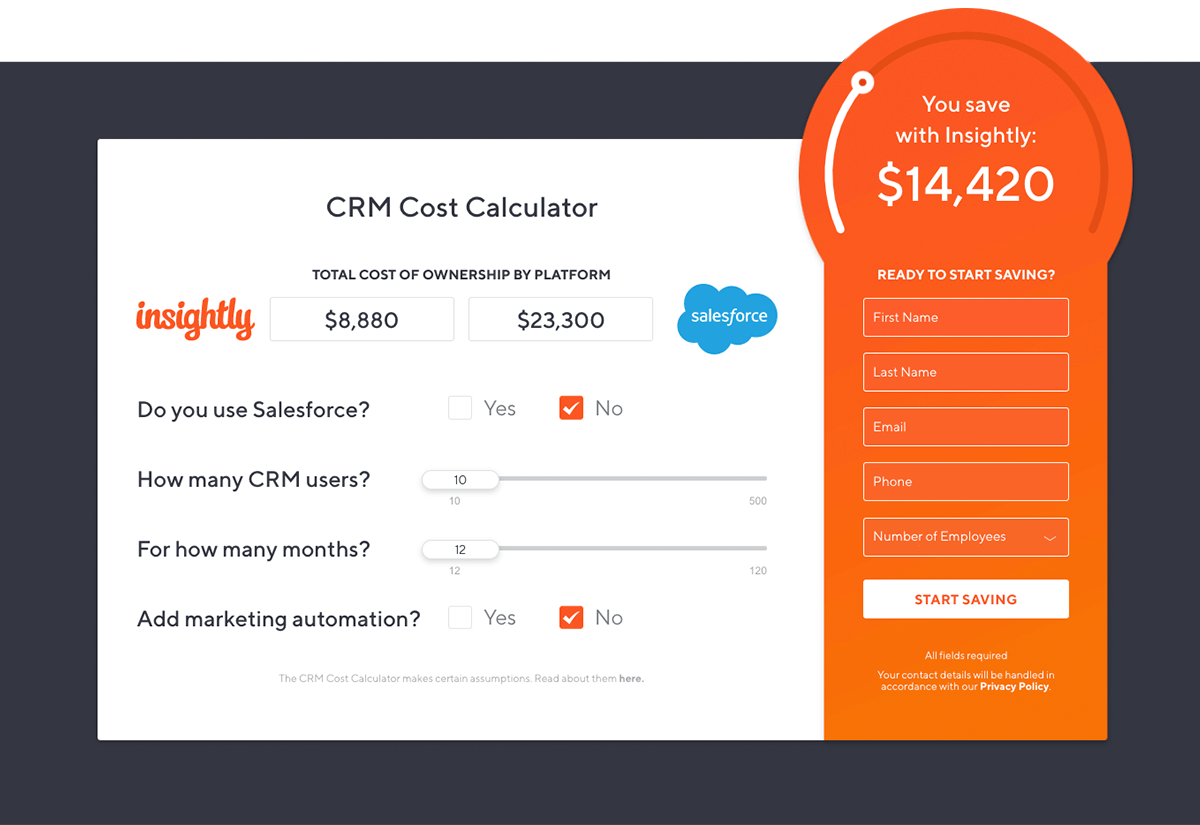
CRM cost calculator
Use a CRM cost calculator to compare costs between a legacy CRM, like Salesforce, and Insightly, based on a number of users/licenses and time horizon.
Read more like this:
- How to do a CRM needs assessment
- 4 questions to ask when evaluating CRMs for a midsize business
- How to ensure a smooth transition to a new CRM
- 3 reasons your legacy CRM is slowing down growth
- Switching CRMs vs. staying put
- Why companies switch to Insightly CRM
- How to eliminate the need for costly CRM consultants
The post How to calculate CRM costs appeared first on Insightly.
]]>The post How to ensure a smooth transition to a new CRM appeared first on Insightly.
]]>Whether you’re just considering a switch or you’ve already decided, now is the time to begin developing your CRM transition plan.
This guide walks you through the multi-faceted endeavor of switching CRMs and how to increase your chances of success with your new system.

Create a transition plan
Start by identifying a realistic cutover or “go live” date
If your legacy system has been around for years and your data needs significant scrubbing, then your cutover date could be several months away. On the other hand, if your company’s CRM contains data that doesn’t require much cleaning and has a simple data structure, then a 30-day go-live plan may be feasible.
Remember to ask key stakeholders about their availability. Your timeline will certainly be delayed if your IT Manager is about to embark on a three-week hiking trip in the Rocky Mountains. Setting aggressive goals is important, but some variables will be outside of your control.
Select a project lead
Who at your company has the right leadership skills and technical know-how to ensure the project’s success? For many organizations, this responsibility falls on someone in sales or IT. Look for someone who possesses the right mix of authority, communication skills, and empathy. After all, your CRM will be used by many people across many departments, so it’s important to consider the needs of all primary users and stakeholders.
Identify key dates & unanswered questions
Work backwards from your cutover date. Make a list of all the major milestones that must be accomplished to achieve your goal. Flag any unanswered questions that may delay your timeline.
If your new CRM offers built-in project management capabilities, go ahead and start using the system to manage the cutover process. If you’re switching to Insightly, you might consider breaking up the project into smaller projects that are tracked on a kanban board.
Build an internal communications plan
One of the main reasons why companies switch CRMs is to increase user adoption. Tell your users about your plan to switch CRMs and include them throughout the entire process. A weekly email newsletter can be a low-cost, low-effort way to keep users engaged and informed. Tell users about upcoming milestones and when their participation or input will be required. Consistently invite users to reply with any questions or suggestions.

Take a strategic look at your CRM data
Bad data plagues most companies to one degree or another. Switching CRMs is your opportunity to lessen bad data’s impact and establish a process for preventing it going forward.
For starters, ask yourself these questions as you evaluate your existing data:
- What data do we actually need to be successful?
- Which data challenges do we currently face and hope to avoid?
- Should some of our custom objects or fields not be migrated to our new CRM?
- Do users rely on workarounds because they lack the right data objects or fields?
- Do we have duplicate records that must be merged or consolidated?
- Which records (i.e., old leads) should be disposed of?
- Does our current vendor make it easy to export our data?
Identifying your current data challenges and deciding what to import (or eliminate) is just the beginning. You must also work closely with your new CRM vendor to understand migration specifications, data import templates, and any limitations.
Planning for vendor terminology discrepancies is also important. For example, one vendor might refer to opportunities as “deals” and opportunity value as “deal size.” Create a data dictionary (use a spreadsheet as a starting point) to ensure each object and field is correctly mapped.
Insightly tip: Here’s a list of Insightly’s default fields.
Migrate data to your CRM & test it
Many CRM vendors offer CSV import templates to help you format your data for their systems. For example, if you’re switching to Insightly, you’ll want to access these sample files. Or, if you’re switching to Insightly from Salesforce, all you need to do is export your Salesforce CRM data and Insightly will migrate it with just one click.
If you need to format your data into the correct templates, remember to check your work before you begin importing data into your new CRM. Take a measured approach and perform adequate quality control at every step of the process. Here’s how:
Import a limited amount of data
Incorrectly importing tens of thousands of records creates confusion and wastes precious time. Initially, try importing a dozen or two records to make sure everything works as planned. You can always delete or merge these records later. Start simple, confirm your assumptions, and expand from there.
Understand your vendor’s built-in deduplication features
Many CRMs check for duplicates automatically when you import your records. Research how your vendor handles duplicates prior to uploading large data files. This step may save you hours of unnecessary spreadsheet work.
Compare your record counts
After completing each data import, be sure to compare the number of records in your CSV and CRM. Is there a disparity? If so, why? Do not assume that everything was imported correctly. Implement checks and balances to avoid oversights.
Check data reports for data linking issues
Use your CRM’s built-in data reports to proactively identify record linking issues. For example, let’s assume that you notice that your contacts and organizations are not linking properly. Perhaps you forgot to include the contact’s organization when importing your contact database. Or, perhaps you imported something in the wrong order. Either way, review your vendor’s support documentation and keep working on your data.
Tap into the collective genius of your organization to identify data problems
One person can only do so much. Two or more people, when working in close alignment, can do great things—and, CRM testing is no exception. Collect feedback from a few users across departments, teams, and proficiency levels.
Train your teams on how to use the new CRM
Users need to know how to use your new CRM to its fullest extent. They need to know how to enter, view, and manage their data—from anywhere and on any device. They also need a reliable process for asking questions, making recommendations, onboarding new hires, and staying up to speed on feature releases.
That’s why proper training and support is a vital component for any CRM transition.
Most CRM companies, like Insightly, offer success plans that provide onboarding and implementation support. Take a serious look at one of these packages and decide if it’s right for your needs. If you don’t have the in-house expertise (or capacity) to adequately train and onboard users, then a CRM success plan may pay for itself.
Smooth sailing with your new CRM
Implementing a new CRM can be challenging. It’s also an excellent opportunity to convert your business data into something more meaningful and valuable.
Take time to plan out your transition, look at your data strategically, migrate with prudence, and keep your users well-trained. In doing so, your CRM will become what you’ve always wanted it to be: the source of truth that helps you accelerate your company’s growth.
Ready to switch? Request a demo and a free needs assessment with Insightly to see if it’s the right choice for your business.
The post How to ensure a smooth transition to a new CRM appeared first on Insightly.
]]>The post New: UI & productivity improvements across all Insightly apps appeared first on Insightly.
]]>Watch Q3 2020 Product Release Webinar where Insightly CEO Anthony Smith showcases all new features and improvements.
User Interface Enhancements
Over the past few months Insightly customers had requested a few user interface (UI) improvements. For example, the ability to show more than six records on one of the related tab grids when viewing an individual record. For datasets with hundreds of related records, scrolling through six records at a time can be a lot of clicks.
We solved this with the new feature that allows you to view 50 records at a time, potentially saving you a lot of clicks. When you click on the title of a related tab grid, you are now taken to a new page that shows just that grid and 50 records at a time.
The next UI request we had received was the ability to set the default tab that’s open when you’re viewing records. The Details tab is the tab we have open by default when viewing any record in Insightly. Now we allow you to configure which tab you want to set as the default tab. For example, in some record types, like Opportunities or Products, it may make sense to have the Related tab or the Activities tab open by default.
In this latest product release we’re also adding brand new Insight Cards on the right hand side rail of the Details page in Contacts, Opportunities, and Quotes. On the Contacts page, we already show different opportunities for that contact. We are now adding a new insight card for the primary organization related to the contact, opportunity, or quote you are viewing. You get all the pertinent details on the linked organization right there in a card on the right hand side. No extra clicks.
Finally, we’ve updated the security modal that pops up when you click on the padlock in the header of any Details page. We now show a lot more information about the record, including the current user viewing it, their role and profile, and the page layout that is used to render the page. So, if you have a lot of page layouts and you’re not sure which one is currently being used, clicking on the padlock icon will now tell you that.
These features will all be available in October 2020.
Platform & Productivity Improvements
We have doubled the number of API calls per second with our fantastic REST based API. On the 3.1 level API and above, you can now make an API call every 100ms or 10 calls per second. This is a big win for heavy API users.
We’ve also made a couple of improvements to workflow automation in this product release. We now provide customers with a complete and comprehensive log of all workflow executions: when they occurred, what records they affected, and how long they ran for.
You can now dig in to see if a specific workflow automation ran and if the rules you had in place worked the way you expected. If you’ve got a lot of workflow automations or they are highly complex, this can be a real boon in diagnosing issues or understanding what is happening behind the scene.
You can now also clone workflow criteria and save a lot of time. For example, you might have built up a complex workflow criteria set with quite a few filters. Now you can clone that criteria set in just one click, without having to duplicate it for a different set of actions.
Last quarter we released audit logging. Now we’re adding a new field history report that breaks down the changes to every field and the before and after results of every single field change, along with the user and time and date of that change. So, admins can now schedule an audit report that’s generated and emailed to them for every record and every field change for the objects they need to track for compliance purposes.
We also made improvements in Products, Pricebooks, and Quotes. You can now reorder products and quote line items on a quote. So you can choose which products appear in what order on any quote.
We added a couple of new related grids to the Product Details page. So when you’re viewing an individual product, you can now see which quotes and opportunities included that product.
Finally, you can now use merge documents functionality in Products, so you can easily generate product sheets and the like.
Here’s a quick summary of improvements:
- Increase in API calls per second up to 10
- New comprehensive workflow log of all executions, date and time, records affected, and execution time
- Clone workflow criteria in 1 click
- New field history report for audit logging
- Now reorder products and quote line items
- New related grids on product details page for quotes and opportunities
- Merge documents functionality now available for products
All these features are available in Insightly right now.
To learn about all big new features in Insightly Marketing in this product release, please read this post or watch the full webinar.
Please remember to always check the “What’s New” section in the Insightly Help Center to keep up with our monthly product improvements. We usually ship between 10 to 20 improvements every month. You can also get in touch with your Insightly Customer Success Manager to get more details.
New to Insightly and want to learn more? Contact us for more information at [email protected].
The post New: UI & productivity improvements across all Insightly apps appeared first on Insightly.
]]>The post 6 workflow automation best practices to streamline sales pipeline appeared first on Insightly.
]]>That being said, trying to do too much without the right mix of people and technology can cause deals to go to waste.
To help sales reps elevate productivity in today’s “socially distanced” selling environment, many companies are taking a fresh look at workflow automation. When used properly, workflow automation helps reps get more done with less effort, and close more deals.
Here are six best practices for using workflow automation to streamline your sales pipeline.

1. Avoid automation (for now) & shore up your pipeline
Workflow automation is defined as the use of technology to reduce or eliminate the manual aspects of a business process. It is not a magical solution to fix all of your sales problems. In fact, when used in tandem with a poorly constructed sales pipeline, workflow automation may make a bad situation even worse.
To illustrate my point, let’s assume that a company’s sales pipeline for its ideal customer profile (ICP) consists of four stages:
- Needs analysis
- Value proposition
- Price quote
- Closed won (or lost)
The company’s sales reps reliably move opportunities from stage to stage, but deals consistently get stuck in price quotes. Seeking to accelerate deal velocity, the sales manager designs a complex workflow that involves numerous tasks and emails so that reps perform their necessary follow-up activities. Despite even the best intentions, this approach will likely fail because it does not address the root issue. Reps don’t need more emails crowding their inboxes. Maybe they just have a hard time differentiating between deals that are being quoted and those that are already quoted and require follow-up. In this case, simply adding another stage to the pipeline (i.e., “quote follow-up”) might be more effective and help reps structure their work with fewer distractions.
Key question: Does the sales pipeline in your CRM accurately represent your sales process? If not, it’s time to make a few changes.

2. Collect a list of your sales pipeline bottlenecks
Let’s assume that your sales pipeline is aligned with your CRM. Now the automation can begin, right? Maybe not. Here’s why.
Although creating workflows in your CRM should be relatively easy, doing so consumes scarce resources. With sales teams leaner than ever, you don’t have unlimited time available for configuring an unlimited number of automations. You must be selective and only build automated workflows that will deliver tangible value to your business.
Slow down and make a list of the current bottlenecks in your pipeline. If you can’t think of any, look for these warning signs:
- Processes that require significant amounts of data entry
- Things that consistently get “stuck’ in the pipeline
- Processes that require manual coordination with third-party systems
- Data silos
Key takeaway: Create a shared document or kanban board to collect your sales pipeline bottlenecks. Share the list with everyone involved in the sales pipeline and crowdsource ideas.

3. Know what your CRM can do
You don’t need to hire an expensive CRM consultant to understand how your CRM’s automation works. Spend time reading your CRM vendor’s automation documentation (for example, check out Insightly’s automation guide). Ask yourself these questions as you dive in:
- Which CRM records (i.e., leads, contacts, etc.) can be used to trigger an automated workflow?
- Does my CRM allow me to use multiple criteria (i.e., bid amount, deal status, etc.) when building automated rules?
- Can actions be scheduled to occur on a future date rather than occurring immediately?
- What are the different types of actions (i.e., send an email, update a record, etc.) that are available?
Reminder: Don’t forget to check if workflow automation is included in your current CRM plan level. If it’s not included, perform a basic ROI analysis to determine if the cost of upgrading is worth it.
4. Sequence your biggest pain points
Now it’s time to sequence your bottlenecks to decide what you should automate first. Remember, you want to identify the one thing that will have the biggest impact on your sales pipeline but is also easy to implement (given your CRM’s capabilities as previously discussed). There are numerous ways to do this, but I suggest keeping it simple:
Impact
Large = 1 point
Medium = 2 points
Small = 3 points
Size
Small = 1 point
Medium = 2 points
Large = 3 points
If you’re using Insightly, you might use tags to assign an impact and size rating to each item. Then use your project kanban board to drag and drop cards into a logical order. Use a golf-like scoring methodology to give preference to cards with low scores (i.e., large impact, small size).
Bonus tip: If there’s a tie between two or more cards, ask for feedback from other stakeholders in the sales pipeline. After all, you want buy-in on the automation that you’re building.
5. Automate one sales workflow at a time
Notice that the headline says one workflow—and not several.
Don’t be tempted to automate too many things at once, especially if this is your first attempt at automation. There are enough decisions to make in building a single workflow. Distributing your focus will only lessen your ability to think strategically and clearly.
For the sake of discussion, let’s imagine that you’ve identified inbound lead automation as the highest impact, lowest effort initiative. Your SEO and paid promotion is paying off and generating more inbound inquiries; however, you lack a scalable system to deal with the influx. You’re looking to automate the following steps to engage more inbound leads and reduce manual effort:
- Immediately send a welcome email to the lead
- Assign a task to an SDR for follow-up
- Send a second email a few days later
If you’re an Insightly user, check out this helpful guide, How to configure an automated workflow. Before you start making any adjustments in your CRM, however, it’s wise to diagram your ideal workflow. Use descriptive words to explain exactly what you want to happen. Here’s a simple illustration:
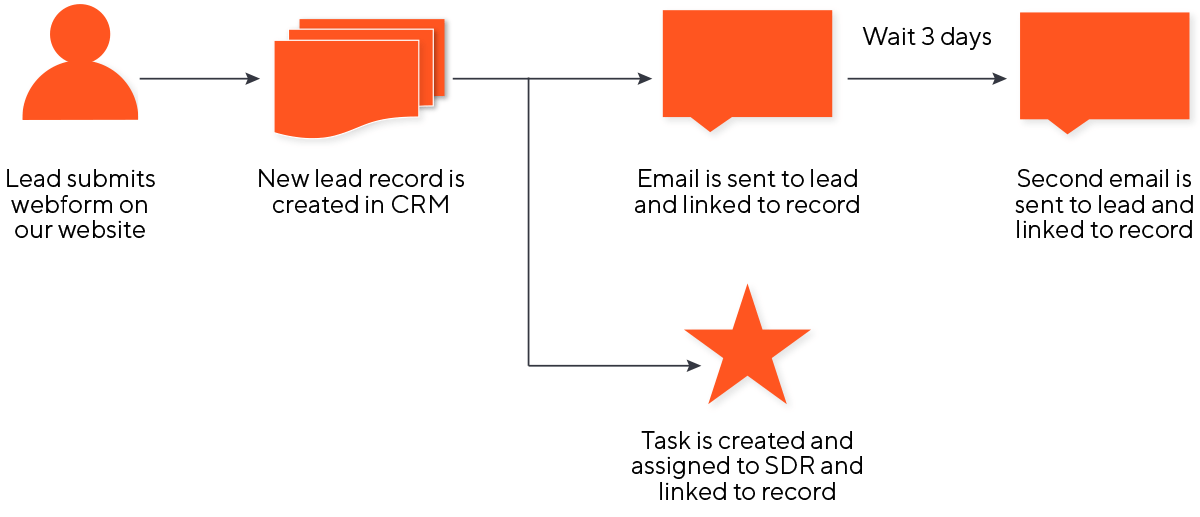
Use your diagram as a guide for implementing workflow triggers and actions that help you achieve your goal. Refer back to it often—especially if you feel like you’re getting lost in the weeds when evaluating workflow criteria.
Suggestion: Test your workflow in a limited scope before rolling it out across your entire sales team. During testing, you might assign automated tasks to yourself instead of to your SDRs. This approach allows you to make any final adjustments and ensure everything is working as intended.

6. Use data to measure success & plan your next move
Workflow automation should have a measurable impact on your sales key performance indicators (KPIs). In an example with inbound lead automation, you can expect to see a noticeable improvement in one or more of the following areas:
- Email response rate from inbound leads
- SDR appointments with inbound leads
- MQL-to-SQL ratio for inbound leads
Use data from your CRM to track desired and actual outcomes. If, after a few months, you notice very little change (or a change for the worse), perhaps it’s time to make a few adjustments. Ask users for their input, too. What seems to be working? What makes their lives easier? What, if anything, has created new challenges? Look for opportunities to improve and continuously refine the workflows that you build.
Insightly tip: Insightly dashboards can help you visualize your data so you know what to tweak and what to automate next.
CRM automation helps you scale your sales pipeline
Automated CRM workflows play a pivotal role in helping you create a more scalable sales process. Shore up your existing CRM pipeline, understand your vendor’s capabilities, and use data at every step of the process to build workflow automations that make an impact.
Continue reading about CRM workflow automation to see what it can do for your business.
If you want to learn about Insightly CRM’s advanced workflow automation capabilities, request a free demo and see how you can better equip your sales team.
The post 6 workflow automation best practices to streamline sales pipeline appeared first on Insightly.
]]>The post 4 questions to ask when evaluating CRMs for a midsize business appeared first on Insightly.
]]>After all, you’ve grown beyond startup mode, which means you can’t just pick the first system that you come across. Your company has far too many stakeholders, departments, and moving parts. On the other hand, you’re not a massive enterprise with unlimited financial resources and in-house IT expertise. You’re somewhere in between.
Before going any further in the CRM selection process, ask yourself these four important questions.

1. Do other midsize companies use this CRM?
Most software companies—CRM vendors included—are well aware of their ideal customer profiles (ICPs) and buyer personas. Marketers use these ICPs and personas to craft messaging that creates alignment throughout the buyer journey. Spend a few minutes on a vendor’s website with this in mind, and you’ll quickly learn if your company fits the mold.
For example, imagine that a vendor touts itself as the “CRM to help you go from idea to successful launch.” Obviously, this vendor’s ICP includes companies that are still in early startup mode—which does not describe your business. Making this solution work for your needs might be more difficult than finding a CRM that’s built for the unique challenges of midsize companies.
Your next move: Read plenty of customer stories from a variety of CRM vendors. How many articles spotlight other midsize customers? Do you notice any success stories from your exact or similar industry? Your ideal vendor should offer numerous examples of how they have helped other midsize companies in your cohort group.
2. Is data management intuitive & customizable?
You’re not putting a man on the moon with this project. At the end of the day, you just need an easy-to-use, scalable system that can help you manage relationships, organize your data, and maximize alignment.
To achieve these goals, you need a CRM that provides an intuitive way to collect and store essential business information, such as contacts, leads, opportunities, emails, and other important records. Getting data into your CRM should be easy for users and not dependent on manual data entry.
Integrations to inboxes and other systems should simplify data collection, allowing users to stay focused on engagement. Built-in safeguards should prevent record duplication and ensure data integrity. And, being able to rename standard objects in your CRM (i.e., changing “Opportunities” to “Deals”) or creating your own objects gets everyone talking the same language, eliminating unnecessary confusion.
Your next move: Does your current CRM make it difficult to customize objects or field labels? Or, if you’re using a spreadsheet or home-grown system, perhaps data is inconsistent and unreliable. Make a list of all of your current data management headaches. Then, identify CRM vendors who offer innovative solutions for overcoming these challenges.

3. Can we save money & improve efficiency?
Stop and think about all of the systems that your teams use to manage work. One system for order management. Another for marketing campaigns. Still another for projects and personal to-do lists. The list goes on and on. Implementing the right CRM may never completely solve your system overlap problems. That being said, there’s a good chance that it can help.
For the sake of discussion, let’s assume that your company has identified Insightly CRM on its shortlist of vendors. You’re intrigued by Insightly’s built-in project and task management features, which could potentially eliminate the need for your existing third-party project management system. System consolidation could deliver immediate cost savings (assuming that you’re on a paid plan with the project management software vendor).
In addition, you will be able to align your sales, marketing, and service data and teams under one roof. For example, instead of manually setting up projects in a separate system after opportunities close (or via complex data integrations), you’re now able to convert closed-won deals into projects with a few clicks.
Your next move: Ask your assistant to prepare a list of all your current software vendors. What exactly are you paying for? Talk to users and find out how they’re using your legacy systems. Look for similar functionality in the CRMs that you’re considering. Maybe system consolidation could partially (or completely) offset the cost of your CRM implementation.

4. Will this CRM scale to align with our future growth?
Ideally, selecting a CRM should be a long-term decision. No matter how intuitive a system might be, users must be fully onboarded and trained. Data management and quality control procedures take time to develop, refine, and document. Not to mention, your business is constantly evolving and adapting. The last thing you want to do is jump between CRM vendors every 12 to 24 months.
Pick a CRM that can handle your future growth. You may only have 50 users today, but what about five years from now? To double revenue and hit your goals, you may need to bring on more SDRs and AEs. What would doubling your user base do to your annual subscription cost? More users generate more activity, create more contacts, and require more data storage. Will the vendor place artificial restrictions on users based on a massive uptick in record count? What would be the cost of upgrading to a plan that offers unlimited file storage, marketing capabilities, and integrations? Is this even possible with every vendor that you’re considering?
Your next move: Revisit your corporate goals for the next five to ten years. Now, imagine that you’re successful in realizing those goals. Which CRM most closely aligns with your current and future vision of success? Don’t sacrifice the future for the here and now.
Ask the right questions to find the right CRM
Ask the right questions and get your team thinking critically. Critical thinking leads to more questions and healthier conversations, which, in time, help you hone in on the right CRM for your midsize business.
If you’re ready to discuss your questions with a CRM provider, then request a demo with an Insightly rep. You’ll get a free needs assessment and a chance to see Insightly CRM at work.
The post 4 questions to ask when evaluating CRMs for a midsize business appeared first on Insightly.
]]>





